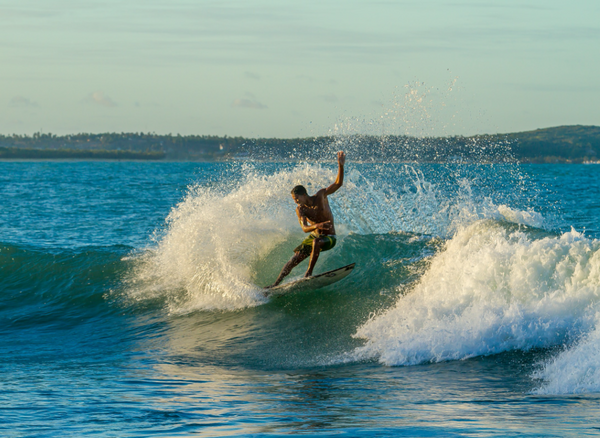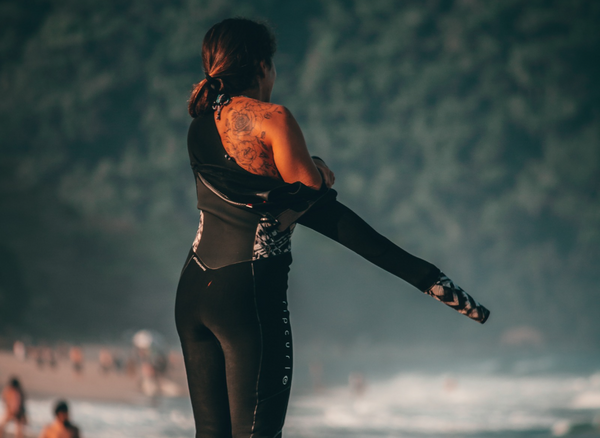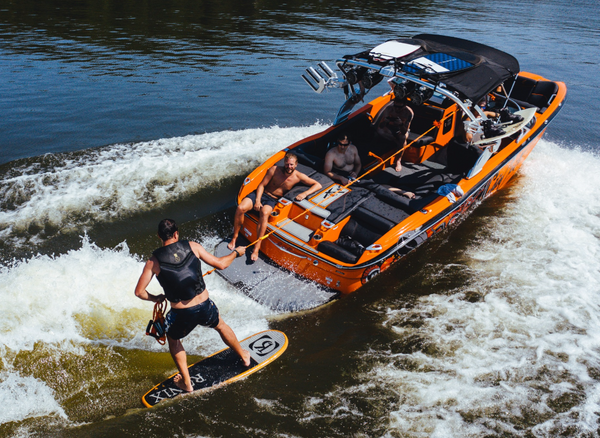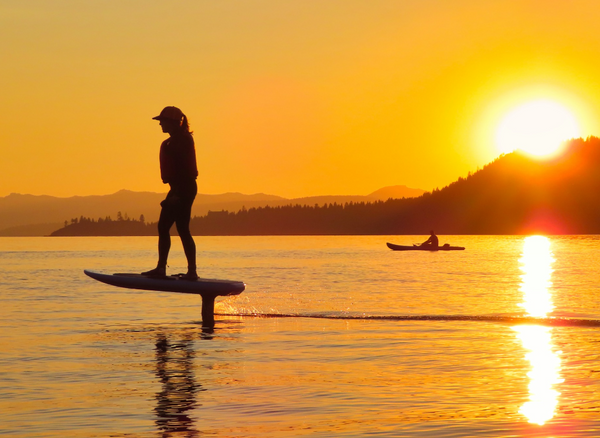Picture yourself gliding across the water, feeling the exhilaration of catching a wave, and experiencing the freedom of the ocean beneath your feet. This is the thrill of surfing, an adventure that awaits those who dare to learn. While the journey to becoming a skilled surfer may seem daunting, understanding the factors that influence the learning process can help you set realistic expectations and achieve your goals. So, how long does it take to learn to surf? The answer depends on your fitness, prior experience in board sports, and commitment to consistent practice.
In this blog post, we will explore the learning curve in surfing, the stages of surfing progression, the role of surf lessons and coaching, essential surfing equipment, and the importance of surf etiquette and safety. By the end, you’ll be ready to dive into the world of surfing and embark on your own wave-riding adventure.
Keys
- Surfing is achievable with guidance and dedication.
- Fitness, board sport skills & commitment are key to fast progress in surfing.
- Professional coaching, right gear & respect for other surfers help create a safe environment for learning to surf.
The Learning Curve in Surfing
Several factors, including fitness, prior experience, and commitment, influence the learning curve in surfing. Getting a handle on these can help you set achievable progress goals. For example, during your first surfing lesson with a professional surf coach, you may become familiar with the basics of popping up and maintaining balance on the board. With the right guidance, you could start riding a wave in just 60 minutes. By the fourth week, you may be confidently standing up and surfing down the face of the wave, catching waves with ease.
Hard work and dedication are the cornerstones of successful surfing. Practicing regularly not only speeds up progress but also hones skills. No matter your skill level, continuous self-improvement and learning from peers are integral for every surfer.
Fitness and Surfing
Physical fitness, particularly upper body strength and endurance, is fundamental to mastering surfing basics like paddling and popping up on the board. Staying physically fit will let you maximize your time in the water, which will help you accelerate your learning curve. With 40 to 60 minutes of exercise, you can make the most out of your time and quickly progress your surfing skills.
Balance, vital for maintaining footing and staying upright on the board, significantly contributes to enhancing surfing skills. The quicker you can paddle, the more likely you will be to catch a wave and learn surfing faster. Developing your paddling speed and technique can significantly enhance your ability to catch waves, enabling you to spend more time on the board and less time in the water. Additionally, improving your swimming skills can boost your confidence in the water, further aiding your progress in learning to surf.
Building a strong foundation in fitness and balance is a stepping stone to success on your surfing journey.
Prior Experience in Board Sports
Prior experience in board sports like skateboarding, wakeboarding, or snowboarding can help with balance and coordination, making it easier to learn surfing. Board sports such as skateboarding, snowboarding, and wakeboarding involve balance, coordination, and control, which are all key elements for beginner surfers. By developing these skills in other board sports, you can gain an edge when it comes to learning to surf and practicing effectively.
Experience in board sports provides a nuanced understanding of water dynamics, aiding wave reading and quick technique adjustments, giving surfers an advantage. This can help surfers progress more quickly in their surfing journey and master the most demanding skills with greater ease.
Commitment and Consistency
Commitment and consistency are the driving forces behind surfing progress, leading to rapid results for those who invest time and effort in practice. Consistent and persistent practice is the key to unlocking your potential in surfing and mastering the most demanding skills. By setting goals and focusing on improving specific mistakes, you can maximize your progress in this exciting motion sport.
Embracing dedication and hard work catalyzes quicker results, paving the way to becoming a proficient surfer.
Remember, every individual’s surfing learning process is unique. Factors such as personal fitness, prior experience in board sports, and commitment to practice will all impact the speed at which you progress. The key is to stay persistent, learn from your mistakes, and enjoy the journey.
Stages of Surfing Progression
Surfing progression can be divided into three stages: beginner, intermediate, and advanced, each with its own set of skills and techniques to master. The beginner stage is an exciting opportunity to learn the basics of paddling, popping up, and riding small unbroken waves on a larger surfboard, making it feel like a real-life surfing game.
As you progress to the intermediate stage, you’ll hone your wave selection skills, practice turns and maneuvers, and gain the confidence to tackle larger surf. Finally, in the advanced stage, you’ll develop more advanced maneuvers like cutbacks and aerials and master different types of waves.
Recognizing the stages of surfing progression aids in setting achievable goals and expectations for your surfing journey. By focusing on the skills and techniques required at each stage, you can ensure that you’re building a strong foundation in surfing and continually challenging yourself to improve.
Beginner Stage: Mastering the Basics
In the beginner stage, emphasis is laid on mastering basic skills like popping up, paddling, and maintaining balance on the board. This exciting first stage of surfing progression is an ideal time to learn the fundamentals and build the foundation you’ll need for more advanced skills. With just a few surfing lessons, you can gain a handle on the basics and be ready to hit the waves.
Consistent practice and a focus on refining form are vital during this stage. With the guidance of a professional surf coach, you can learn the proper techniques and avoid developing bad habits that could hinder your progress later on. As you gain confidence on the board, you’ll be ready to practice surfing on more challenging waves and advance to the next stage of surfing progression.
Intermediate Stage: Riding Waves Properly
The intermediate stage is all about mastering wave riding, including executing turns on the surfboard and sustaining longer rides down the line. Going down the line means riding the swell of a wave before it breaks - a thrilling experience. Mastering this skill is essential for furthering your skills and technique, leading to the ability to perform tricks and other maneuvers.
By mastering these techniques, intermediate surfers will gain greater control and maneuverability, enabling them to ride waves properly and take their surfing skills to the next level. As you progress through the intermediate stage, you’ll continue to build on the foundation you developed in the beginner stage, refining your techniques and preparing for more advanced challenges.
Advanced Stage: Expert Maneuvers and Techniques
The advanced stage of surfing necessitates the execution of expert maneuvers and techniques like:
- Cutbacks
- Bottom turns
- Floaters
- Re-entries
These maneuvers are typically performed on larger waves. To reach expert-level surfing, you’ll need to consistently surf in spots that provide larger, more powerful waves. Developing the ability to catch most waves you paddle for, always stay on the line, and perform even the most advanced maneuvers is an impressive accomplishment.
Selecting the right gear, such as shortboards, deck pads, and top-notch fins, is essential for advanced surfing. As you master expert maneuvers and techniques, you’ll continue to push the boundaries of what’s possible on a surfboard and truly embody the spirit of the sport.
The Role of Surf Lessons and Coaching
Surf lessons and coaching can markedly accelerate the learning process and surfing progression. Whether you’re learning the basics or perfecting your technique, having a friend or coach in the water can help you learn quickly and efficiently. A surf instructor can help you with:
- Getting you up and riding the wave
- Optimizing your positioning
- Recognizing when to start paddling
- Choosing the best wave
The choice between surf school and self-taught methods hinges on personal preferences, budget, and resource availability. However, professional guidance can speed up the learning process and ensure a more enjoyable and safer experience.
Let’s explore the benefits and drawbacks of each approach, and the importance of finding the right surf instructor for your needs.
Surf School vs. Self-Taught
The two exhilarating methods of learning to surf are surf school and self-taught. Surf school offers expert tips on how to perfect your form and avoid bad habits, as well as access to professional guidance and equipment. However, the cost and availability of surf schools may be a barrier for some learners.
On the other hand, self-taught surfers can enjoy the cost savings and flexibility to learn at their own pace, but may miss out on professional guidance and risk forming improper habits. When deciding between the two methods, it’s important to consider your personal preferences, budget, and access to resources. Both surf school and self-taught methods can lead to success in surfing, but professional guidance can help accelerate the learning process and ensure a more enjoyable experience.
Choosing the Right Surf Instructor
Finding the right surf instructor is essential for effective learning, as they can provide personalized guidance, wave selection, and technique improvement. A great surf instructor will have the experience, knowledge, and teaching methods to ensure you have a fun and successful surfing experience. Taking surf lessons can help you master the basics of surfing quickly and safely, as well as help you rapidly progress in your surfing skills.
When looking for a surf instructor, it is important to:
- Research their experience and qualifications
- Read reviews
- Ask for references to make sure you get the best experience possible
- Ensure that the instructor is certified and insured for your safety and peace of mind.
With the right surf instructor by your side, you’ll be well on your way to becoming a good surfer, mastering the art of surfing and enjoying a good surf session.
Essential Surfing Equipment
Choosing the right surfing equipment can simplify the learning process and enhance enjoyment. From choosing the right size board to selecting the perfect wetsuit, having the right gear can significantly enhance your ability to stand on the board and optimize your overall performance. In addition to a surfboard and wetsuit, other essential surfing equipment to maximize your surfing experience includes:
- A leash
- Fins
- Wax
- A rash guard
Opting for the right equipment is key to maximizing the benefits of your surfing journey. With the proper gear, you can focus on improving your skills and technique, rather than struggling with ill-fitting or inappropriate equipment that could hinder your progress.
Surfboard Selection
Surfboard selection hinges on factors like size, material, and personal body characteristics. Beginners are usually advised to start with larger boards. Larger boards offer better balance, making them an ideal choice for those starting out. Choosing the right surfboard can significantly enhance your ability to stand on the board and optimize your overall performance.
When selecting a surfboard, it is important to consider your skill level, body type, and the type of waves you will be riding to ensure you get the best experience possible. Trying out different boards before making a purchase can help you find the perfect fit for your surfing needs.
Wetsuit and Accessories
A well-fitted wetsuit and suitable accessories like fins and deck pads can uplift performance and ensure safety during the learning process. A wetsuit is made of neoprene and designed to keep you warm and comfortable in cold water, helping to reduce exhaustion and enabling you to stay in the water for longer. Fins, deck pads, and leashes are all must-haves for getting the hang of surfing, providing you with the control, grip, and comfort you need.
When selecting a wetsuit and accessories, it’s important to consider the water temperature and the type of activity you will be doing. With the right gear, you can maximize your performance, safety, and enjoyment while learning to surf.
Surf Etiquette and Safety
Observing surf etiquette and safety is crucial to foster a respectful and enjoyable environment for all water users. Observing surf etiquette and safety is essential for creating a respectful and enjoyable atmosphere for all water users, making your surfing experience even more rewarding.
Before embarking on a surf session, one should familiarize themselves with the dynamic patterns of the waves and the ocean. Showing respect to other surfers is essential to maintain a safe and enjoyable atmosphere for everyone in the water.
An understanding of ocean conditions, including wave quality and potential hazards, is vital for safe and effective surfing. By staying informed about current and forecasted ocean conditions, you can ensure your safety while enjoying water activities like:
- swimming
- surfing
- boating
- diving
Understanding Ocean Conditions
An understanding of ocean conditions, including wave quality and potential hazards, is vital for safe and effective surfing. By staying informed of the current and forecasted ocean conditions, you can ensure your safety while enjoying water activities such as:
- swimming
- surfing
- boating
- diving
In addition, understanding ocean conditions is essential for planning recreational activities, such as finding the best spots and maximizing your surfing experience.
Being knowledgeable of ocean conditions is also vital for protecting our environment. By understanding factors like water temperature, salinity, and nutrient levels, we can better monitor and assess the impact of climate change, pollution, and other human activities on marine life. With a greater understanding of ocean conditions, we can contribute to the conservation of our oceans and the creatures that call them home.
Respecting Other Surfers
Maintaining a positive atmosphere in the water hinges on:
- Respecting fellow surfers
- Following surf etiquette
- Avoiding wave-stealing
- Signaling your intentions
Respecting other surfers can benefit us through increased safety, a more enjoyable surfing experience, and the fostering of a supportive surfing community. By not stealing someone else’s wave, signaling our intentions, and giving way to more experienced surfers, we can show respect for our fellow surfers and enhance our own surfing experiences.
Not respecting other surfers can result in hazardous conditions, a hostile environment in the water, and a tarnished reputation for the surfing community. By observing surf etiquette and safety, we can create a respectful and enjoyable atmosphere for all water users, making our surfing experiences even more rewarding and memorable.
Frequently Asked Questions
How many years does it take to learn surfing?
Learning to surf takes a varying amount of time depending on the individual, their dedication, and the environment. For some, it can take just a few weeks to learn the basics, while for others it could take several months or even years to become an experienced surfer.
Is it hard to learn to surf?
Learning to surf takes time and practice, so it can be difficult; however, with the right attitude and determination, anyone can become a good surfer.
Is 35 too old to learn how to surf?
No, 35 is not too old to learn how to surf! With enough dedication and determination, you can achieve your goal of surfing regardless of your age.
What are the stages of surfing progression?
Surfing progression includes three distinct stages: beginner, intermediate, and advanced, each providing its own set of unique challenges to master.
Is surf school or self-taught better for learning to surf?
For those looking to learn how to surf, professional guidance through a surf school may be the better route as it can offer both access to resources and speed up the learning process.
Summary
Learning to surf is a thrilling journey that involves dedication, commitment, and a willingness to learn. From mastering the basics to perfecting expert maneuvers and techniques, the surfing experience can be both challenging and rewarding. By understanding the learning curve, the stages of surfing progression, and the role of surf lessons and coaching, you can set realistic expectations and goals for your surfing journey.
Embracing the importance of fitness, prior experience in board sports, surf etiquette, and safety, as well as selecting the right equipment, will ensure you have a successful and enjoyable time in the water. So, grab your surfboard and wetsuit, dive into the waves, and embark on your own surfing adventure. The ocean is waiting for you!








